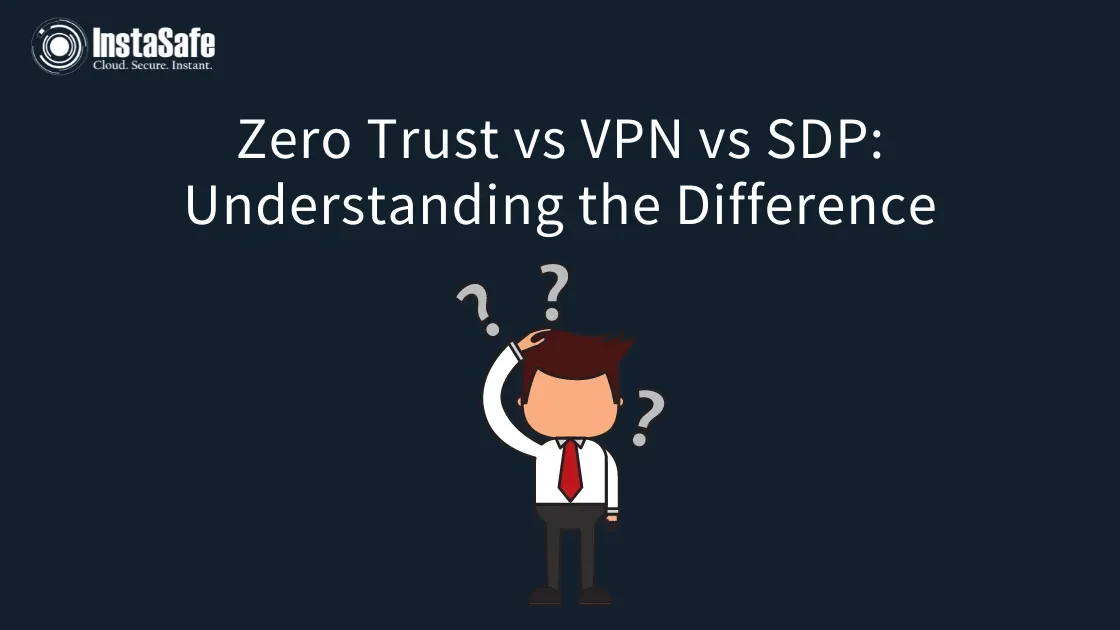Zero Trust vs VPN vs SDP: Understanding the Difference

Network security and communication requirements continuously evolve and change with time as cyberattacks and online threats become more advanced and sophisticated. The need for a robust network security solution has especially increased since the onset of the global pandemic and remote working environment.
According to research, 55% of companies have employees that work remotely, and 50% of business data is stored and accessed via the cloud. As a result, the risks of cybersecurity threats and data breaches are equally likely to be inside the network perimeter as outside.
Thus, businesses are looking for better and more sophisticated cybersecurity solutions to protect their network and critical data. While VPNs hae been helping organisations secure networks, businesses are shifting towards modern solutions like Software-Defined Perimeters (SDP) and Zero Trust Security solutions.
If you’re looking for a comprehensive and modern network security solution—you’re at the right place. In this article, we’ll see how VPN, SDP, and Zero Trust differ from each other and which one you should opt for your organisation. Let’s go!
What is a VPN?
VPN or Virtual Private Network refers to a network access approach based on secure virtual tunnels to connect workers, employees, or branches for remote access. It was designed to protect users and workers across public networks.
VPNs require user authentication to allow access to users outside the network and tunnel them inside the network. As a result, only users inside the network can access and see all the network assets and gain overall network visibility.
VPNs encrypt the traffic and hide user identity in real-time. However, some major drawbacks of VPNs include high network latency, slow performance, and not being designed for cloud computing and Software-as-a-Service (SaaS) solutions.
Here are some of the significant disadvantages of VPNs:
- VPNs rely on open ports to establish VPN connections—making it easy for cybercriminals to gain network access.
- VPNs come with inadequate authorisation and identification of users and their devices—unlike SDP and Zero Trust solutions.
- VPNs provide unrestricted access to all the users inside the network—making network data, assets, and applications exposed to cyber threats and increasing the attack surface area.
- Many VPN systems consist of software problems and vulnerabilities used by hackers to exploit the network by scanning unpatched VPN software.
- VPNs provide a bad user experience due to network latency, and setting up VPNs is highly inconvenient, expensive, and time-consuming.
Now, let’s see how SDP and Zero Trust are different from VPNs.
What is Software-Defined Perimeter (SDP)?
Software-Defined Perimeter is a newer-age security approach—also known as Black Cloud. It hides internet-connected assets and infrastructures like routers and servers from outside parties and network attackers—whether on the cloud or on-premises.
Hence, while VPNs relied on the network perimeter, SDP defines new software-based perimeter security—offering the perimeter security functionality to data centres, internal software entities, applications, and network environments.
Thus, unlike VPNs—SDP hides assets within the network from the users and only provides specific access to users when they request the same. Furthermore, it uses controllers for continuous validation and authentication of the users for network access.
Many use SD with the Zero Trust security architecture interchangeably. However, there’s a difference between these two.
What is Zero Trust?
Zero Trust Security is a new and the most robust network security solution based on the principle of trusting no one within or outside the network perimeter. It enables and assures secure remote access to network applications and services based on the access control regulations.
The Zero Trust security framework assumes every user to be an attacker or an untrusted entity—restricting automatic network access and visibility to the network assets and applications.
It requires a tight identification and verification process to grant access through a secure encrypted channel. In addition, Zero Trust uses micro-segmentation instead of network segmentation to ensure user and device authentication for every application, asset, and network environment.
While Zero Trust sounds much like SDP—SDP is a network architecture that instates the Zero Trust Network solution principle.
Now, let’s look at the major difference between these three network security solutions in a tabular format.
VPN vs Zero Trust vs SDP
Conclusion
To combat the sophisticated data breaches and project network assets and applications from the cybercriminals—organisations are shifting from traditional VPNs to much more secure Zero Trust Network solutions.
When we talk about Zero Trust vs VPN—Zero Trust is gaining momentum, and 72% of respondents from a 2021 global survey responded that they plan to opt for Zero Trust security in the future.
Thus, if you wish to adopt the Zero Trust Security model for your organisation, check out our InstaSafe Zero Trust Security solutions for secure remote and application access and ensuring granular visibility and better user experience. Book a demo today and contact us to know more!
Key Products
MFA | I&AM | ZTNA | Zero Trust Application Access | Secure Enterprise Browser
Key Features
Single Sign On | Endpoint Security | Device Binding | Domain Joining | Always On VPN | Contextual Based Access | Clientless Remote Access | Device Posture Check
Key Solutions
VPN Alternatives | DevOps Security | Cloud Application Security | Secure Remote Access | VoIP Security
